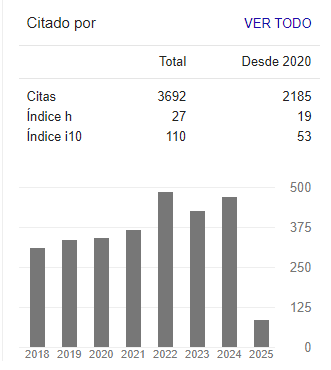DOI:
https://doi.org/10.14483/23448393.3834Published:
2011-12-18Issue:
Vol. 16 No. 2 (2011): July - DecemberSection:
ArticleCentroide de un Conjunto Difuso Tipo-2 de Intervalo: Continuo vs. Discreto
Centroid of an Interval Type-2 Fuzzy Set: Continuous vs. Discrete
Keywords:
Centroide, Algoritmo Karnik-Mendel, Algoritmo recursivo, conjunto difuso tipo-2 de intervalo. (es).Keywords:
Centroid, Karnik-Mendel algorithm, interval type-2 fuzzy set, recursive algorithm. (en).Downloads
Abstract (es)
El algoritmo de Karnik-Mendel presenta siempre dos procedimientos independientes para calcular el centroide de un conjunto difuso tipo-2 de intervalo: el primero calculando su extremo izquierdo (denotado como c l ) y el segundo calculando su extremo derecho (denotado como c r ). Esto a´un es cierto en diferentes versiones del algoritmo que han sido propuestas en la literatura. En la versión discreta del centroide no hay problemas relacionados con la convergencia dado que existe un número finito de términos para sumar. Por otro lado, la versión continua tiene algunos problemas relacionados con la convergencia. Este artículo presenta una discusión simple donde se muestra que el cálculo de c l y c r en su versión discreta es el mismo problema y no dos problemas diferentes. También se muestran algunos problemas relacionados con la convergencia del centroide en su versión continua.
Abstract (en)
Karnik-Mendel algorithm involves execution of two independent procedures for computing the centroid of an interval type-2 fuzzy set: the first one for computing the left endpoint of the interval centroid (which is denoted by c l ), and the second one for computing its right counterpart (which is denoted by c r ). Convergence of the discrete version of the algorithm to compute the centroid is known, whereas convergence of the continuous version may exhibit some issues. This paper shows that the calculation of c l and c r are really the same problem on the discrete version, and also we describe some problems related with the convergence of the centroid on its continuous version.References
N. N. Karnik and J. M. Mendel, “Centroid of a type-2 fuzzy s et,” Information Sciences, vol. 132, pp. 195–220, 2001.
J. M. Mendel and F. Liu, “Super-exponential convergence of the Karnik-Mendel algorithms for computing the centroid of an interval type-2 fuzzy set,” IEEE Transactions on Fuzzy Systems, vol. 15, no. 2, pp. 309–320, April 2007.
J. M. Mendel, “On centroid calculations for type-2 fuzzy sets,” Appl. Comput. Math., vol. 10, no. 1, pp. 88–96, 2011.
H. Bernal, K. Duran, and M. Melgarejo, “A comparative stud y between two algorithms for computing the generalized centroid of an interval type-2 fuzzy set,” in Proceedings of the IEEE International Conference on Fuzzy Systems (FUZZ 2008), 2008, pp. 954–959.
M. Melgarejo, “A fast recursive method to compute the gener alized centroid of an interval type-2 fuzzy set,” in Annual Meeting of the North American Fuzzy Information Processing Society NAFIPS 2007, San Diego, California, USA, June 2007, pp. 190–194.
L. K. Durán and M. A. Melgarejo, “Implementación hardware del algoritmo Karnik-Mendel mejorado basada en operadores CORDIC,” Ingeniería y Competitividad, vol. 11, no. 2, pp. 21–39, 2009.
J. M. Mendel and H. Wu, “Uncertainty bounds and their use i n the design of interval type-2 fuzzy logic systems,” IEEE Transactions on Fuzzy Systems, vol. 10, no. 5, pp. 622–639, 2002.
J. M. Mendel and R. I. John, “Type-2 fuzzy sets made simple,” IEEE Transactions on Fuzzy Systems, vol. 10, no. 2, pp. 117–127, 2002.
J. M. Mendel and H. Wu, “New results about the centroid of a n interval type-2 fuzzy set, including the centroid of a fuzzy granule,” Information Sciences, vol. 177, pp. 360–377, 2007.
O. Salazar, J. Soriano, and H. Serrano, “A short note on t he centroid of an interval type-2 fuzzy set,” in Proceedings of 2012 Workshop on Engineering Applications (WEA), Bogotá, Colombia, May 2011.
How to Cite
APA
ACM
ACS
ABNT
Chicago
Harvard
IEEE
MLA
Turabian
Vancouver
Download Citation
License
From the edition of the V23N3 of year 2018 forward, the Creative Commons License "Attribution-Non-Commercial - No Derivative Works " is changed to the following:
Attribution - Non-Commercial - Share the same: this license allows others to distribute, remix, retouch, and create from your work in a non-commercial way, as long as they give you credit and license their new creations under the same conditions.





2.jpg)










